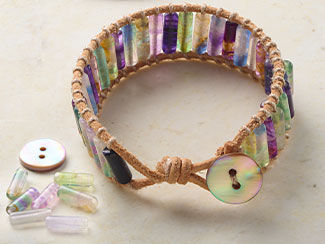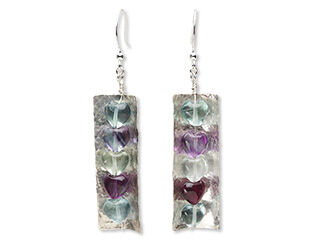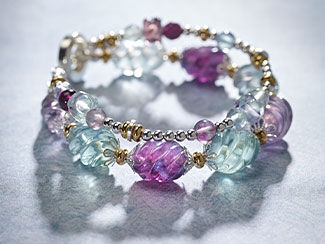Fluorite Meaning and Properties
Fluorite History
Fluorite, also called fluorspar, comes in a variety of colors including shades of purple and lavender, clear and green banded as well as yellow, green, blue-green, white and rainbow. Its name comes from the Latin word "fleure" which means "to flux," which in turn means, "flowing out" or "continuous change." Fluorite properties, such as its fluorescence under ultraviolet light and its effectiveness as a flux in steelmaking, make it valuable in both scientific and industrial applications.
Discover the history, unique appeal, and natural beauty of rainbow fluorite in this informative video. Gemologist Dev provides expert insights on design possibilities and proper care techniques. A step-by-step project tutorial is also included at the end.

What are the Metaphysical Properties of Fluorite?
Fluorite is aligned with the astrological signs of Pisces and Capricorn. It is believed to cleanse and purify the body and stabilize energy, increasing the ability to concentrate and helping one to understand and maintain relationships. It is said to promote impartiality for unbiased reasoning. It is called a stone of discernment and aptitude, making it an excellent learning aid. Fluorite is thought to heal arthritis and headaches.
What is Fluorite Made From?
Fluorite properties include crystalizing in many forms, including masses, grains, columns and cubes. Deposits have been found in Germany, Argentina Brazil, Burma (Myanmar), England, France, Norway, China, Namibia, Austria, Switzerland, Peru, Mexico and the state of Illinois in the United States.
- Mineral Information: Calcium fluoride
- Chemical Composition: CaF2
- Color: Purple, violet, clear and green banded
- Hardness: 4 (Mohs)
- Specific Gravity: 3.18
- Refractive Index: 1.434
How Do You Clean Fluorite?
To clean fluorite, use warm water and a mild soap. Wash the surface with a soft cloth and remove any soap residue. Do not use harsh chemicals because they present a high risk of damaging the surface. Since fluorite is a colored mineral, the use of sonic cleaners or steamers should be avoided. Fluorite can easily be scratched with a knife or other sharp objects, so fluorite jewelry should be stored separately from any other jewelry items that can easily scratch it.
Fluorite FAQ
Q: Where is fluorite found?
A: Deposits have been found in Germany, Argentina, Brazil, Burma (Myanmar), England, France, Norway, China, Namibia, Austria, Switzerland, Peru, Mexico and the state of Illinois in the United States.
Q: What color is fluorite?
A: Fluorite comes in a variety of colors including shades of purple and lavender, clear and green banded as well as yellow, green, blue-green, white and rainbow.
Q: Can fluorite be in the sun?
A: Sunlight will cause fluorite to fade, so protect your fluorite gemstones adequately!
Q: Can you put fluorite in a fish tank?
A: Fluorite can be used in aquariums, but be cautious. Some fish are sensitive to it, so do your research before you add fluorite to your tank. In addition, some varieties of fluorite can have trace amounts of other minerals that may be harmful to your aquarium inhabitants.
Q: Does fluorite glow?
A: Fluorite exhibits fluorescence under ultraviolet light, often glowing blue due to impurities like europium.
Q: How rare is fluorite?
A: Fluorite is abundant and can be found in regions worldwide. Some varieties, however, are less common.
Designing with Fluorite
Fluorite adds a refreshing touch wherever it appears. Whether you wear the translucent lavender or the medley of cool rainbow colored beads, the effect is the same. Rainbow fluorite beads offer a range of colors and variety of fascinating shapes that blend with and complement solid color gemstones so beautifully. And, like nature's rainbow, each rainbow fluorite bead is unique and lovely.
A Few Design Ideas to Get You Started
Shop for Fluorite
**Please note that all metaphysical or healing properties listed are collected from various sources. This information is offered as a service and not meant to treat medical conditions. Fire Mountain Gems and Beads® does not guarantee the validity of any of these statements.
How did you like this resource? Your feedback helps us provide resources that matter to you most.
Copyright Permissions
All works of authorship (articles, videos, tutorials and other creative works) are from the Fire Mountain Gems and Beads® Collection, and permission to copy is granted for non-commercial educational purposes only. All other reproduction requires written permission. For more information, please email copyrightpermission@firemtn.com.




